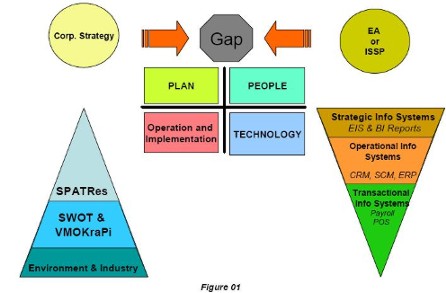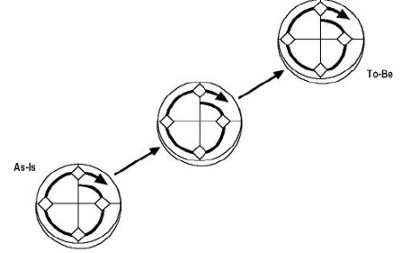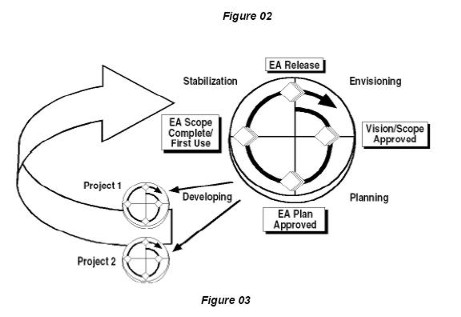
|
 Formulating
an Information Formulating
an Information
System Strategic Plan
Prof.
Arup Maity, PMP, MBM
President & CEO – Blastasia Inc.
Professor, Asian institute of Management
Member PMI
E-Mail: arup@blastasia.com
|
The
job of a system architect is in some ways very similar to the job of a
building or civil architect. It requires knowledge of various disciplines,
imagination and some amount of courage to think out of the box.
An information system at the very basic state is supposed to help knowledge
people by cutting down the drudgery of repetitive ‘no brainer’
work. ‘No brainer’ does not mean non-logical; in fact, it
might help using logic to sieve through mountains of data and arrange
it in a logical way. That is why; one of the first uses of computers and
information systems has been in the field of book keeping in accounting.
Activities like capturing transactions for sales, processing of payroll,
were also amongst the initial uses of computer systems in business.
The
purpose and use of information system in the beginning was targeted towards
reducing manual labor and increasing efficiency and thus reducing cost
of doing business. Cost has thus been the ‘primal instinct’
justification for the usage of Information system in companies. Management
seems to still use this justification even in today’s day and age
because the IT salesman still thinks it’s the best and only way
to get management buy-in. Moreover, as most other rationales used for
IS have proved hard to sell, both the IT sales teams and their customers
find a comfort zone in cost savings. This could also be because both sides
(from all their previous experiences) are convinced of their failure before
they even start out on a different track. The past experiences, in most
cases were times they tried, half heartedly probably, without enough experience
and failed. These failures have resulted in the baby being thrown out
along with the dirty water.
Systems are usually laid out at different levels. The lowest rung in the
ladder is taken by the TRANSACTIONAL information system. These are ones
like ‘Pont Of Sales’ systems used in the store counters, or
book keeping systems mentioned earlier. These are
systems targeting cost reduction, capturing repetitive activities and
assisting the human using it to become more efficient in handling larger
volumes of transactions.
The
OPERATIONAL or operation support systems are usually build combining several
Transactional systems in a logical sequence so as to make the operation
of any particular division/functional group more efficient. Classic example
is the integration of Accounting, Payroll, HR, and Inventory, Production
etc. to form a MRP or ERP system. Or POS, Customer Account Info, Accounting,
etc. linked together to form a CRM system. A very critical component for
operational systems is their reporting systems. They provide thereports
that combine and merge the reports/information from several transactional
systems to provide reports to help executives manage operations in a synchronized
and
optimized manner. Thus, they act as enablers and help managers to keep
track of various parameters so as to keep the whole operation smooth and
efficient.
STRATEGIC
systems are little more complicated. They cross the regular operational
boundaries and become tools that form the basis for senior management
to plan, execute and monitor the organization. They help in keeping track
of the Key Performance Indicators by combining and logically sorting information
from various Operational and Transactional systems all across the company
and at times combining it with external information from sources like
the stock market, industry sources, partners and even competitors. Designing
STRATEGIC information system requires a thought process of a ‘good’
CEO with an understanding of the business from the top, various
information sources present in the company and outside in platforms that
need to be collated, combined and extracted into a tool to help run the
company in a more informed and responsive manner.

*
To find the details on this figure, see the sub note at the end of this
document
The
diagram above shows the process of building a Corporate Strategy, gathering
information from the industry, injecting the capability of the company
and strategizing towards reaching the desired objectives (Vision and Mission
from a much broader perspective). This then becomes one of the basic materials
for the person designing an Enterprise Architecture or Information System
Strategic Plan. A quick study of the organization at this stage on the
four critical areas of IT health is very essential. This would require
the mapping of the current Enterprise Architecture on the above four critical
parameters to analyze the gap between the current state to the future
desired
state of the company and the systems therein.
Looking
further at these four quadrants, it is important to realize that a basic
PLAN or an IT road map is basically required as the step by step implementation
plan for various systems in line with budget and the organization’s
strategic objectives. The Plan should spell out the details of a coordinated
approach to reaching the envisioned state.
The
PEOPLE Issue represents the readiness of the organization to absorb technology
and awareness factors. This if overlooked can be a major cause of failure
for any plan during the implementation phase.
The
success in OPERATION and IMPLEMENTATION will define the capability of
the corporation to handle projects in information technology. It dwells
in the realm of readiness in terms of implementing complex IT projects
and then managing them afterwards. Process and technology related trainings
at times are needed before throwing the in-house team out in the hands
of vendors and consultant.
The
last quadrant focuses on the study of the existing TECHNOLOGY platform
within the company, the infrastructure, the state and format of the data
and information present. Along with all this, the governance of technology
is also something to watch out for. It becomes important to manage the
chaos that would naturally result from too many ‘technology’
cooks in a company. The standards, responsibility and approval structure
in selecting and implementing technology choices have to be clear and
specific in order to avoid pain of integration and obsolescence.
Like in any business, even if the owner does not formally maintain a book
of account, there will always be a balance sheet. It might just need to
be recorded and balanced; the same is the case with the Enterprise Architecture.
Even if there is no documented EA, every company does have a certain state
of EA that should be recorded.
When we get into building or developing a new EA, we need to take a look
at the existing EA, do a gap analysis of it from the Strategic Plan requirements
and then develop a plan to step by step update the current state to the
desired future state in a coordinated logical series of projects.


Now
getting down to the details of how to go about finding the gaps in existing
systems and what is needed to measure the Key Performance Indicators.
One of the several methods of analysis could be to use Michael Porter’s
Value Chain model. Once we successfully draw out the various operations
and the interrelations between the information generated and used we can
get a first hand view of the ‘nervous system’ of a
company. Once we start thinking of assessing the form and format in which
this information is captured and processed and then compare it with our
desired informationrequirement we can immediately get a glimpse of the
missing systems and data capturing needs.
This is just the start. The next thing we need to build after checking
against the other four parameters we discussed is an implementation plan
as per the priorities. Factors that become critical at this stage are
the availability of budget, the gaps had ascertained, the urgency and
the alternatives we can identify. All plans should be supported through
a justification on the basis of cost savings, (but, of course) opportunity
cost and strategic rationale like competitive advantage, perception etc.
amongst other factors.
To
conclude, it would be important to look at the EA planning as a one way
street where we get the Strategic Plan and use it to develop an EA to
align with it. Sometimes, technological advancement and new technology
can open doors to doing old things in a new way. The foremost example
would be in the case of eCommerce after cutting out the hype and failures
of DotComs. The then-declared-dead industry has now opened doors as a
useful strategic tool for businesses leading the new millennium thus creating
the logic and rationale to make the CIO an extremely important management
position so as to provide the technology possibilities in the strategic
plan other then to serve its needs.
Sub
note Figure 01.
1) SPATRes: S- Strategy
P- Plan
A- Action Points
T- Tactics
Res- Resources
2) SWOT: S- Strength
W- Weakness
O- Opportunities
T- Threats
3) VMOKraPi: V- Vision
M- Mission
O- Objectives
Kra- Key Result Areas
Pi- Performance Indicator
|

